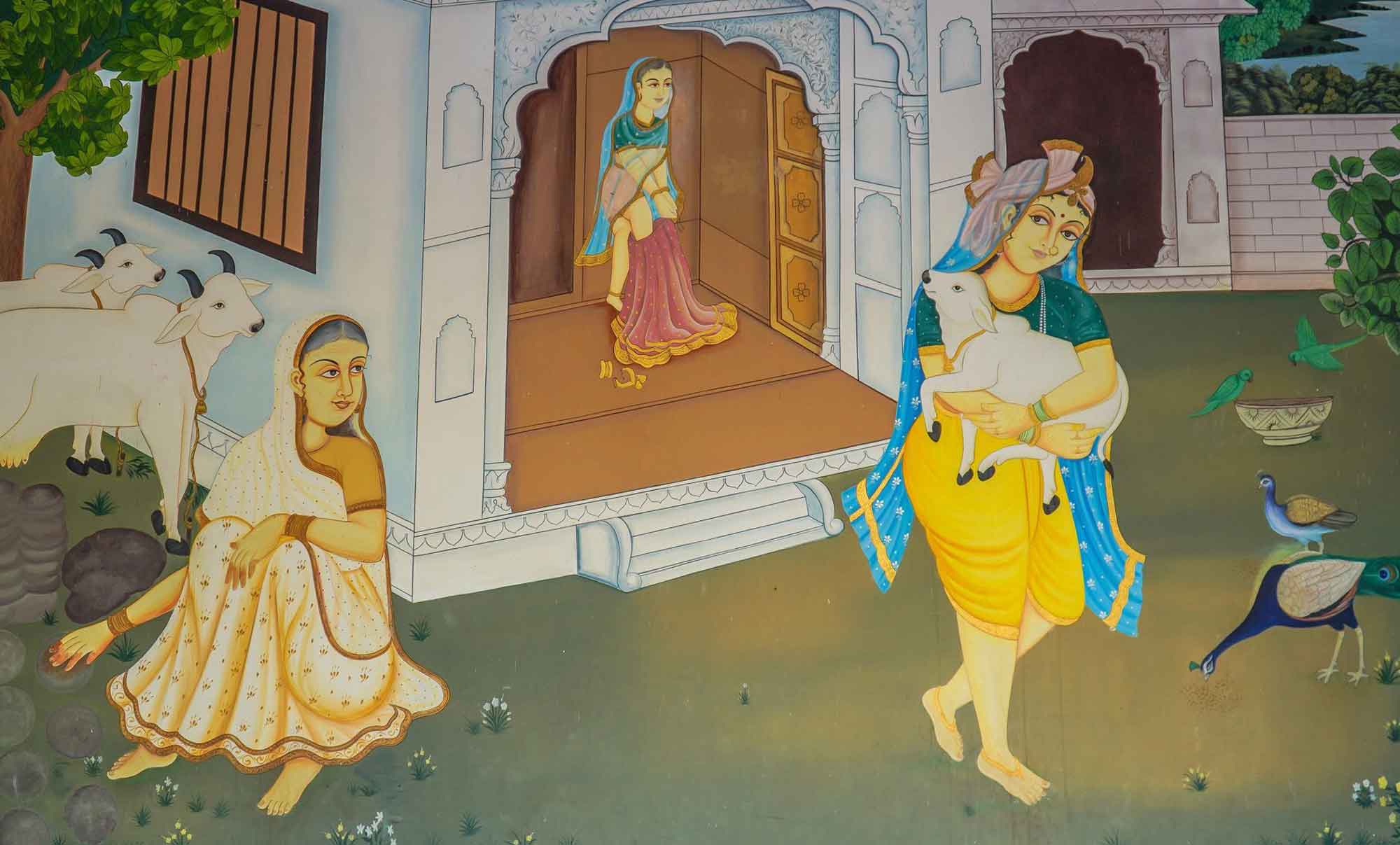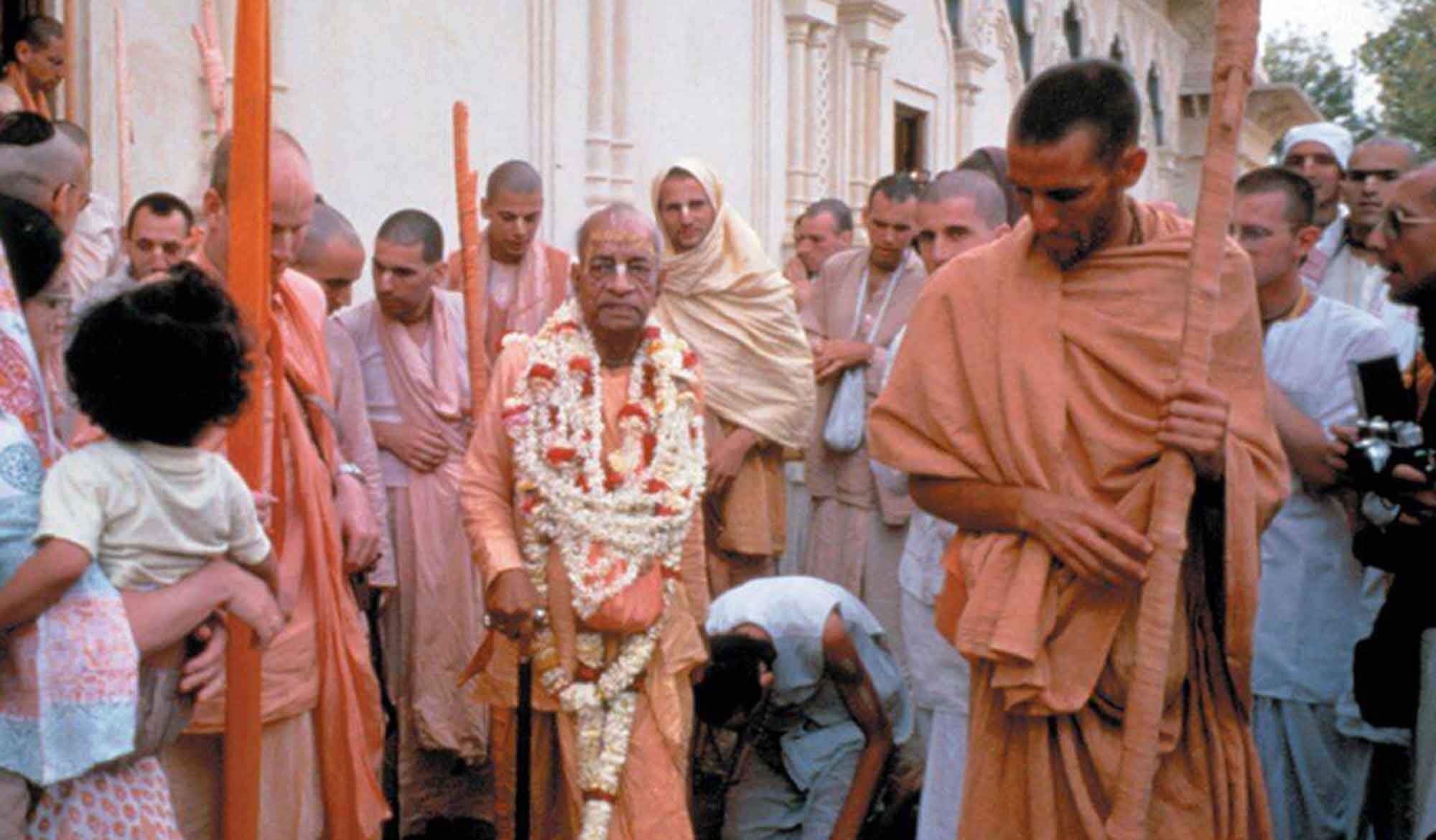by Swami B.G. Narasingha
‘OṀ – The Supreme Combination of Letters Emanating from the Flute of Śrī Kṛṣṇa’ was written by Swami Narasingha in 1999. In this article Narasingha Maharaja discusses the importance of Oṁ and connects it to the kāma-bīja, Klīṁ and the Mahā-mantra.
Oṁ, the supreme combination of letters denotes the Supreme Entities Śrī Rādhā-Kṛṣṇa and indicates the acme of spiritual tendency inherent in all jīva souls. Although, Oṁ is known and recognised widely in almost all spiritual cultures of Eastern philosophy from the Buddhists of Tibet, to the Vedantist of Banaras, to the Theosophists of Los Angles, at present only Śrī Caitanya Mahāprabhu and His sampradāya have actually understood the full transcendental meaning of Oṁ given in the Veda, the Upaniṣads, the Vedānta and the Śrīmad Bhāgavatam.
In the Ṛg Veda we find the following information:
oṁ ity etad brahmaṇo nediṣṭaṁ nāma yasmād uccāryamāna
eva saṁsāra-bhayāt tārayati tasmād-ucyate tāra iti
oṁ āsya jānanto nāma cid-viviktan mahaste viṣṇo
sumatiṁ bhajāmahe oṁ tat sat
tato ‘bhūt trivṛd-oṁkāro yo ‘vyakta prabhavaḥ svarāṭ
yat tal-liṅgaà bhagavato brahmaṇaḥ paramātmānaḥ
“One who chants Oṁ, which is the closest form of Brahman, approaches Brahman. This liberates one from the fear of the material world, therefore it is known as tāraka-brahman. O Viṣṇu, Your self-manifest name, Oṁ, is the eternal form of cognisance. Even if my knowledge about the glories of reciting this name is incomplete, still, by the practice of reciting this name I will achieve that perfect knowledge. He who has unmanifested potencies and is fully independent, manifests the vibration oṁkāra, which indicates Himself. Brahman, Paramātmā, and Bhagāvan are the three forms He manifests.”
Oṁ is described throughout the Vedic literature and by the ācāryas, great spiritual masters, as the seed conception of theism. In the words of Śrīla Śrīdhara Mahārāja:
“Oṁ means ‘Yes’. Always, wherever we cast our glance to search, in one word the answer is ‘yes’. Yes, what you are searching for, is. You are searching for happiness, pleasure, joy, fulfilment. You are in want, and in one word, ‘yes’, fulfilment is there. Oṁ takes the form of Gāyatrī, then Veda and Vedānta-sūtra; then it takes the shape of Śrīmad Bhāgavatam and the līlā, the divine pastimes of the Lord.”
As a tree or fruit bearing creeper begins with a seed so everything begins with Oṁ; the Gāyatrī mantra begins with Oṁ, the Vedas begin with Oṁ, the Upaniṣads begin with Oṁ, the Vedānta begins with Oṁ, and the Śrīmad Bhāgavatam begins with Oṁ. Therefore, it can safely be said that our search for Śrī Kṛṣṇa begins with Oṁ.
Oṁ is the seed of theism, nonetheless, there is a class of philosophers known as māyāvādīs who suggest that Oṁ denotes Brahman, or the impersonal aspect of the Absolute Truth. This, however, is not the conclusion of the Vedas or the statements of the Supreme Brahman Himself. In Bhagavad-gītā, Kṛṣṇa Himself says, “vedyam pavitram oṁkāra, I am the syllable Oṁ.” As such Oṁ is known as the mahā-vākya (Mahā-mantra) in the Vedas.
Oṁ clearly denotes Kṛṣṇa, the Supreme Personality of Godhead, and the Vedānta-sūtra begins with Oṁ yet the māyāvādī philosophers stress the mantra, tat tvam asi, I am that, or I am God, and they try to give less importance to Oṁ.
Oṁ should never be thought of as impersonal. That is perhaps the greatest misconception amongst many philosophers of transcendence since the time of Śaṅkarācārya. The impersonal misconception of Oṁ has become so popular that even personalist philosophers at the stage of practice are sometimes found to have developed an aversion to Oṁ thinking it a means to impersonal realisation.
Oṁ for that matter is non-different than the sound of Kṛṣṇa’s flute. Oṁ is never impersonal at any time all that can be impersonal about Oṁ is the misconception that one chooses to attach to it. The Gopāla-tāpanī Upaniṣad discusses Oṁ clearly establishing its non-difference from the Supreme Personality of Godhead:
catuh-śabdo bhaved eko hy oṁkāraḥ samudāhṛtaḥ
tasmād eva paro rajaseti so-aham ity
avadhāryātmānam gopālo’ham iti bhāvayet
“The sound vibration Oṁ denotes the catur-vyuha-tattva of Śrī Balarāma, Pradyumna, Aniruddha, and Śrī Kṛṣṇa. As the Oṁ transcends the three qualities of material nature, so also one should know oneself to be beyond the identification with the material body. ‘I am the eternal servitor of Gopāla’ (Śrī Kṛṣṇa the cowherd boy at Vṛndāvana) – this consciousness must be maintained at all times.” (GTU 41-42)
The Gopāla-tāpanī Upaniṣad further enlightens us that from the Devanāgari script, Oṁ, we find the conjunct of four sounds to form one sound – A U M:
rohiṇī-tanayo rāmo a-kārākṣara-sambhavaḥ
taijasātmakaḥ pradyumno u-kārākṣara-sambhavaḥ
prājñātmako’niruddho ma-kārākṣara-sambhavaḥ
ardha-mātrātmakaḥ kṛṣṇo yasmin viśvaṁ pratiṣṭhitam
“The letter ‘A’ denotes Balarāma, the son of Rohiṇī, who is the substratum of the entire universe, who is the Supersoul of the universe. The letter ‘M’ denotes Aniruddha, who is the Supersoul of each individual being in the universe. And the ‘dot’ above the ‘M’ denotes Śrī Kṛṣṇa, the fountain head of all Viṣṇu incarnations.” (GTU 55-56)
Meditation on Oṁ begins in this way and one who has got realised knowledge knows Oṁ to be identical with Kṛṣṇa, vāsudevaḥ sarvam iti sa mahātmā su-durlabhah. Such a great soul is very rare and such a great soul can be understood to be the true knower of the Vedas.
Yet a further enlightened idea found in the Gopāla-tāpanī Upaniṣad establishes the conception of Oṁ as connotative of the Supreme Entities Śrī Rādhā-Kṛṣṇa:
praṇavatvena prakṛtiṁ vadanti brahma-vādinaḥ
tasmād oṁkāra-sambhūto gopālo viśva-sambhavaḥ
“The wise and enlighten sages declare that the svarūpa-śakti of Bhagavān, Śrī Rādhā, being the prime mūla–prākṛti is non-different from Oṁ. Gopāla, Śrī Kṛṣṇa who is the Creator, Sustainer, and Destroyer of the universe is also non-different from Oṁ.” (GTU 58)
To emphasise that the seed of līlā, or eternal pastimes, is inherent in the seed mantra Oṁ, the next verse of the Gopāla-tāpanī (59) states that Oṁ and the kāma-bīja mantra, ‘Klīṁ’ are also non-different.
klīm-aumkārasyaikyatvaṁ paṭhyate brahmavādibhiḥ
mathurāyāṁ viśeṣeṇa māṁ dhyāyan mokṣam aśnute
“The brahmavādīs, men of transcendental wisdom, know it for certain that the kāma-bīja mantra, Klīṁ, and the monosyllable Oṁ are one and the same. One who goes to Mathurā Purī and meditates on Vraja Gopāla, by uttering either Klīṁ or Oṁ, attains the ultimate destination of the soul after giving up this present material body.”
Since Oṁ’ and Klīṁ have been established by the Upaniṣads as non-different, we can thus examine the nature of the Klīṁ mantra to better understand the conception the of rasa-tattva, divine mellows, in Oṁ. Oṁ is complete with rasa, mellows, but it is in a seed form. It is also a fact that mantras such as the Gopāla-mantra and the Kāma Gāyatrī mantra, both of which begin with Klīṁ, and are properly chanted by first uttering Oṁ in the beginning.
Śrīla Viśvanātha Cakravartī Ṭhākura, a most highly qualified realised devotee, has given a substantial illumination of the kāma-bīja mantra Klīṁ, so let us try to understand Oṁ from that realised stand point.
Śrīla Viśvanātha Cakravartī Ṭhākura explains the meaning of kāma-bīja thus:
Klīṁ is the seed, kāma-bīja, or the primary cause of all-love. Kāma-bīja is connotative of the entities Śrī Śrī Rādhā-Kṛṣṇa, the Predominated and Predominating Moiety of the Absolute Truth, respectively. (Klīṁ – that which denotes a subject and gives its attributes by implication)
‘K’ is Kṛṣṇa, the leading Hero, with his personal form of eternity, knowledge, and bliss – ka-kāraḥ puruṣaḥ kṛṣṇaḥ sac-cid-ānanda-vigraha.
‘L’ is celebrated as the blissful happiness of love, the beauty of the pleasure of the Divine Couple. ‘L’ is also celebrated as Lalitā – la-kāro lalitā para.
‘I’ is Śrīmatī Rādhārāṇī, the leading Heroine, who is the eternal Queen of Vṛndāvana – i-kāraḥ prākṛti rādhā.
‘M’ is the sweetness of bliss occurring when the Divine Couple kiss. the bindu, dot, above the ‘M’ is said to be Their kissing, the half-moon shape of the Devanāgari nasal letter is Their embracing.
If one chants Oṁ remembering the words of Gopāla-tāpanī Upaniṣad and the words Viśvanātha Cakravartī Ṭhākura, then one can attain all spiritual perfection. But if one insists on considering Oṁ as a manifestation of the impersonal Brahman, then he certainly cheats himself of the chance of being re-instated as an eternal servant of Śrī Rādhā-Kṛṣṇa. The impersonal conception, as is preached by many of the so-called followers of Śaṅkarācārya, has simply caused a great confusion in the spiritual field and this way of thinking should be strictly avoided by all aspiring devotees. Lord Caitanya Mahāprabhu has personally said, māyāvādī-bhāṣya śunile haya sarva-nāśa – anyone who hears the impersonal commentary of the māyāvāda school is completely doomed.”
If one comes under the sway of the impersonal conception, then he certainly becomes no better than an atheist. Where is the question of theism if one says that God has no form, or that he is God? Theism means that there is God, His Pleasure Potency, Śrī Radha, and Their eternal servants-the jīva souls.
Śrīla Prabhupāda once said:
“The sound of Oṁ in the beginning of every Vedic hymns addresses the Supreme Lord. Because the impersonalists are very much afraid of addressing the Supreme Lord Kṛṣṇa by His innumerable names, they prefer to vibrate the transcendental sound omkara. But they do not realise that oṁkāra is the sound representation of Kṛṣṇa. The jurisdiction of Kṛṣṇa consciousness extends everywhere and one who knows Kṛṣṇa consciousness is blessed. Those who do not know Kṛṣṇa are in illusion, and so knowledge of Kṛṣṇa is liberation, and ignorance of Him is bondage.”
The goal of meditation on Oṁ is never to give up one’s individual identity and merge with the Supreme and that is inherent in the mantra as I have stated in my opening paragraph. The inherent identity of the jīva soul is included in the Oṁ mantra as the eternal servant of Śrī Rādhā-Kṛṣṇa and this is given support by Śrīla Jīva Gosvāmī in his description of the alphabetical constituents of the mantra as follows:
a-kāreṇocyate kṛṣṇaḥ sarva-lokaika-nāyakaḥ
u-kārenocyate rādhā ma-kāro jīva-vācakaḥ
“Oṁ is a combination of letters, A,U,M. The letter ‘A’ refers to Kṛṣṇa. The Letter ‘U’ refers to Rādhā, and the letter ‘M’ refers to the jīva soul.”
Thus, according to Jīva Gosvāmī, the inherent position of the jīva soul in the Oṁ mantra is that of a maidservant of Śrī Rādhā-Kṛṣṇa. Now one may ask the question that if even the service of Śrī Rādhā-Kṛṣṇa is inherent in Oṁ as in Klīṁ, then what need is there to chant the Hare Kṛṣṇa Mahā-mantra?
kṛṣṇa-mantra haite habe saṁsāra mocana
kṛṣṇa-nāma haite pābe kṛṣṇera caraṇa
“The Kṛṣṇa Gāyatrī mantra (or Oṁ) liberates one from repeated birth and death in this world; the holy Name of Kṛṣṇa gives one shelter at the lotus feet of Kṛṣṇa.” (Cc. Ādi-līlā 7.73)
pañcama puruśārtha sei prema-mahā-dhana
kṛṣṇera mādhurya-rasa karāya asvadāna
“Love of Godhead is so exalted that it is considered to be the fifth goal of human life. By awakening one’s love of Godhead, one can attain the platform of conjugal love, tasting it even during the present span of life.” (Cc. Ādi-līlā 7.144)
The Gāyatrī mantra, or Oṁ, helps us up to the stage of liberation, and then the mantra retires. The Holy Name of Kṛṣṇa however continues even after liberation. In fact it is the Holy Name of Kṛṣṇa that enables us to develop spontaneous love of Kṛṣṇa.
Oṁ is considered the bīja, or seed, whereas kṛṣṇa-nāma is considered the phalam, or fruit. The fruit which is sweet and palatable to our taste has the seed within. Thus, Oṁ is considered to be present in kṛṣṇa-nāma. One can say that kṛṣṇa-nāma is also present in Oṁ. That is true, but one cannot taste the sweetness of kṛṣṇa-nāma in Oṁ. Chewing the seed is not comparable to chewing the fruits. The juice of the fruit of the Holy Name of Kṛṣṇa is the sweet taste of pure love of Godhead.
Oṁ emanates from the flute of Śrī Kṛṣṇa; it then manifests as Gāyatrī, then as Veda, then as Vedānta, then as Śrīmad Bhāgavatam, and the last verse of Śrīmad Bhāgavatam recommends the chanting of the Holy Names.
nāma-saṅkīrtanaṁ yasya sarva-pāpa-praṇāśanam
praṇāmo duḥkha-śamanas taṁ namāmi hariṁ param
“Kṛṣṇa’s Holy Name can relieve us from all undesirable sinfulness, all filthy characteristics, and all miseries. Chant the name of Kṛṣṇa! Do this; nothing else is necessary. Take this! Chant the Holy Name of Kṛṣṇa and begin your real life in this dark age with the most broad and wide theistic conception. Let us all bow down to Him.”
Śrī Caitanya Mahāprabhu used to pass His days and nights at Jagannātha Purī in the company of His intimate devotees, tasting the unlimited mellow sweetness of love of Godhead by constantly chanting the Holy Names:
Hare Kṛṣṇa Hare Kṛṣṇa Kṛṣṇa Kṛṣṇa Hare Hare
Hare Rāma Hare Rāma Rāma Rāma Hare Hare
Caitanya Mahāprabhu has composed the Śiksāṣṭakam, eight essential verses, in which He describes the complete development of pure devotion from beginning to end. From these verses we can fully understand the necessity for chanting the Mahā-mantra. In the first verse of Śiksāṣṭakam the Lord says:
ceto-darpaṇa-mārjanaṁ bhava-mahā-dāvāgni-nirvāpaṇaṁ
śreyaḥ-kairava-candrikā-vitaraṇaṁ vidyā-vadhū-jīvanam
ānandāmbudhi-vardhanaṁ prati-padaṁ pūrṇāmṛtāsvādanaṁ
sarvātma-snapanaṁ paraṁ vijayate śrī-kṛṣṇa-saṅkīrtanam
“The Holy Name of Kṛṣṇa cleanses the mirror of the heart and extinguishes the fire of misery in the forest of birth and death. As the evening lotus blooms in the moon’s cooling rays, the heart begins to blossom in the nectar of the name. And at last the soul awakens to its real treasure a life of love with Kṛṣṇa. Again and again tasting nectar, the soul dives and surfaces in the ever-increasing ocean of ecstatic joy. All phases of the self of which we may conceive are fully satisfied and purified, and at last conquered by the all-auspicious influence of the Holy Name of Kṛṣṇa.”
In The Golden Volcano of Divine Love, Śrīla Śrīdhara Mahārāja lists seven transcendental glories of chanting kṛṣṇa-nāma in this first verse of Śiksāṣṭaka. He lists them as follows;
- Kṛṣṇa-nāma cleanses the mirror of the heart.
- Kṛṣṇa-nāma extinguishes the fire of material existence.
- Kṛṣṇa-nāma bestows the supreme goal of life.
- Kṛṣṇa-nāma prepares us for wholesale surrender in mādhurya-rasa.
- Kṛṣṇa-nāma gives us a taste of the infinite ocean of ecstasy.
- Kṛṣṇa-nāma fully satisfies and purifies all phases of the self.
- Kṛṣṇa-nāma is the essential ingredient in all devotional service.
In the subsequent verses of the Śiksāṣṭaka, Śrī Caitanya Mahāprabhu describes the processes of devotional service, namely sādhu-saṅga, bhajana-kriyā, anartha-nivṛtti, niṣṭhā, ruci, kṛṣṇāsakti, bhāva, vipralambha-prema, and prema-bhajana, vipralambha-sambhoga. Those who have realised knowledge of the Holy Name of Kṛṣṇa, by the grace of Śrī Caitanya Mahāprabhu, know the Śiksāṣṭaka to be a description of chanting the Holy Name.
The Hare Kṛṣṇa Mahā-mantra is actually a mādhurya-mantra. It is filled with the most inconceivable sweet nectar of the mādhurya-rasa. The mādhurya-rasa means the sweetest rasa in which all other rasas are accommodated. The mādhurya-rasa is called the mukhya-rasa, or the chief rasa. It is the sweetest and most accommodating rasa.
Śrīla Prabhupāda often used to say that everything is there in the Mahā-mantra. Yes, that is a fact. Not only is Oṁ present in the Mahā-mantra, but the twenty-four hour līlā of Rādhā-Kṛṣṇa known as aṣṭa-kāla-līlā is also non-different from the Mahā-mantra. Śrīla Bhaktivinoda Ṭhākura has explained aṣṭa-kāla-līlā in the Mahā-mantra in his Bhajana-rahasya with reference to the Śiksāṣṭaka prayers:
“In the sixteen-word Hare Kṛṣṇa mantra, there are eight pairs of names. Corresponding to these eight pairs, Caitanya Mahāprabhu has recited the eight verses of Śiksāṣṭaka.The first pair of Names, ‘Hare Kṛṣṇa’ signifies the subduer of ignorance and the performance of nāma–saṅkīrtana with faith. The second pair, ‘Hare Kṛṣṇa’ means Kṛṣṇa’s Names are invested with all potencies. One should have attachment for bhajana by taking shelter of the Holy Names in the association of sādhus. Gradually by performing bhajana, anarthas (unwanted contamination) are destroyed. As anarthas are removed, niṣṭhā (firm faith) develops. The third pair, ‘Kṛṣṇa Kṛṣṇa’ indicates the company of pure devotees and becoming fixed in firm faith throughout the day and night. By the fourth pair, ‘Hare Hare’ unmotivated devotion is awakened along with a taste for nāma–saṅkīrtana. The fifth pair, ‘Hare Rāma’ represents the taste for pure service along with remembrance of the Holy Names as prescribed in the Śiksāṣṭaka. In the sixth pair, ‘Hare Rāma’ chanting in the beginning stage of transcendental emotion leads material detachment and complete attachment to Kṛṣṇa. The seventh pair, ‘Rāma Rāma’ awakens attachment for the mellow of conjugal rasa, the shelter of Śrī Rādhā’s lotus feet, and feelings of separation. The eighth pair, ‘Hare Hare’ leads to attainment of the goal of life, loving service to Rādhā-Kṛṣṇa following in the mood of the gopīs of Vṛndāvana throughout the eight divisions of day and night pastimes, aṣta-kāla-līlā.”
The conclusion is that one who knows the meaning of Oṁ is a real student of the Śrīmad Bhāgavatam, and one who knows the meaning of the Śrīmad Bhāgavatam certainly chants the Hare Kṛṣṇa Mahā-mantra as directed by Śrī Caitanya Mahāprabhu in His Śiksāṣṭaka.
PARAM VIJAYATE ŚRĪ KṚṢṆA SAṄKĪRTANAM
More Articles by Swami B.G. Narasingha
Rādhā-Pāda Darśana
'Rādhā-Pāda Darśana' was written by Swami B.G. Narasingha on November 6th 2009. In this article, Swami Narasingha describes the pastime of Subala Milana, when Rādhārāṇī dressed as Subala to meet Kṛṣna. Narasingha Maharaja also gives a deeper purport to this pastime.
Anartha Nivṛtti
In ‘Anartha Nivṛtti’, published on May 22nd 2001, Śrīla Narasiṅgha Mahārāja stresses the point that the higher topics of kṛṣṇa-līla are not meant for those who have not crossed the stage of anartha-nivṛtti, and quotes extensively from Śrīla Śrīdhara Mahārāja and Śrīla Purī Mahārāja.
Purport to Śrīla Prabhupāda-Smaraṇa-Maṅgala Stotram
'Purport to Śrīla Prabhupāda-Smaraṇa-Maṅgala Stotram' was written by Swami B.G. Narasingha in 1994. This was Narasingha Maharaja's brief commentary to his own composition, 'Śrīla Prabhupāda-Smaraṇa-Maṅgala Stotram' which depicts the pastimes of Śrīla A.C. Bhaktivedānta Swami Prabhupāda. This was later published in the book 'Prabhupāda Vijaya'.













